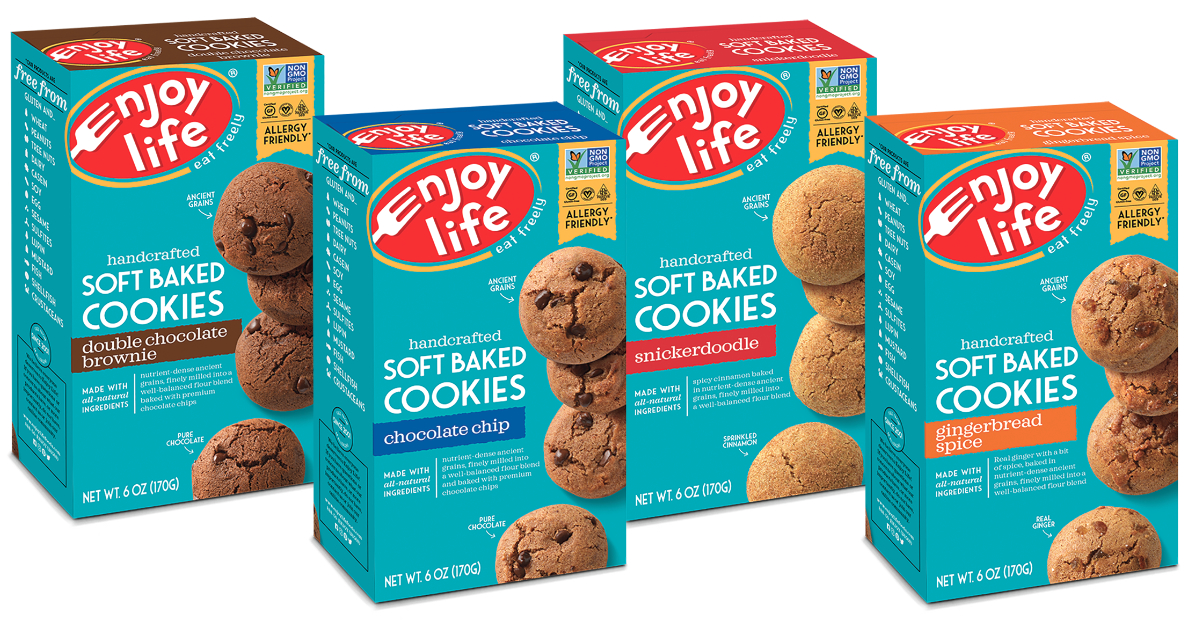KANSAS CITY — The long-term future of free-from products, which are free from certain ingredients, may be up for debate, but data back up the soundness of the allergen-free segment and give credence to using allergen-free alternative ingredients.
As many as 15 million people in the United States have food allergies, including nearly 6 million children, according to Food Allergy Research & Education, which seeks to improve the quality of life and health of people with food allergies. The Centers for Disease Control and Prevention, Atlanta, in 2013 released a study showing food allergies among children increased about 50% between 1997 and 2011.
Besides appealing to people with allergens, allergen-free products also could be consumed by people who daily are around those with allergens. Peanut allergies are a case in point. While close to 1% of the U.S. population is allergic to peanuts, the nut-free trend may involve a community of people that makes up 10% to 15% of the population, said Dennis Reid, vice-president of business development for Inclusion Technologies, Atchison, Kas. Homes may be free of nuts because a family member is allergic to them, and nut-free zones are appearing in school cafeterias.
Dairy-free and nut-free are two of the more popular non-allergen goals, said Cam Suárez-Bitár, market and public relations manager for Pak Group North America, Pasadena, Calif., which owns the Bellarise brand.
“Some U.S. school systems’ efforts to provide allergen-free meal options and safer eating environments have resulted in cafeteria sections being designated ‘nut-free’ zones, for example,” he said. “We are seeing demand for allergen-free bread rise everywhere from the bread aisle to elementary school hallways, and it is up to ingredient producers to create clean label and allergen-free solutions that help commercial bakeries support healthier diets for adults and children alike.”
 Inclusion Technologies offers Nadanuts that provide flavor, eye appeal and texture similar to nuts in a variety of food items. The ingredients may serve as alternatives to nuts like pecans and walnuts.
Inclusion Technologies offers Nadanuts that provide flavor, eye appeal and texture similar to nuts in a variety of food items. The ingredients may serve as alternatives to nuts like pecans and walnuts.
“We’re hoping that people that have to give up eating nuts because of the affliction of their loved ones, they finally understand, ‘Hey, there’s a product out there that is nut-free and will give me all the eating properties of the nut,’” Mr. Reid said.
The Inclusion Technologies plant is free of nuts, but Nadanuts contain two other allergens: wheat and dairy.
The company also offers inclusions formulated to be free from the eight major allergens as defined by the U.S. Food and Drug Administration: milk, egg, fish, crustacean shellfish, tree nuts, wheat, peanuts and soybeans.
Nuggets, flakes and coated sugars from Inclusion Technologies are available in allergen-free recipes. The ingredients may be used in a range of grain-based food applications, including donuts, cookies, cakes, pancakes and waffles. The hardest challenge was replacing wheat flour in nugget recipes, Mr. Reid said. The company uses rice flour in the nuggets now.
The Bellarise brand offers several products free from all the F.D.A.’s major allergens except for wheat, Mr. Suárez-Bitár said. They include a 5% brioche base, a sweet dough improver and a 3% Hawaiian roll improver AF (allergen-free, except for wheat).
“In these particular examples our custom enzyme blends allow us to replace eggs and milk (dairy products) and help bakeries increase efficiency, improve quality control and reduce their liability,” he said.
Custom enzyme systems in the brioche base allow for the right dough strength without the use of eggs. Flavor systems get the taste right without bakeries having to rely on milk.
Since the sweet dough improver is 2%, it may be used in any rich, sweet dough.
“We kept it easy to implement in any production environment,” Mr. Suárez Bitár said. “So no flavor systems are included, allowing commercial bakeries to dial in their own preferred profile.”
In the Hawaiian roll improver, custom softening, dough conditioning and flavor systems allow for the removal of eggs and butter and provide the dough strengthening, emulsifying and taste needed to create allergen-free Hawaiian rolls.
Brolite Products, Bartlett, Ill., offers Huevo NS, which is free of eggs and soy. It contains a blend of emulsifiers, gums, coloring agents, strengtheners and pH modifiers, said David DelGhingaro, company president. Huevo NS works well in all baked products with the exceptions of angel food cake, meringues and egg washes, he said.
“In cakes, it will be able to replace about 30% of the eggs in the formula,” he said.
The ingredient does not require refrigeration or thawing.
“It’s easy to scale, and it doesn’t add additional allergens to a formula,” Mr. DelGhingaro said. “Because of this, no clean-out between runs is required.”
Is eight enough?
Several companies kept multiple allergens out of new products launched this year. Nestle Toll House Simply Delicious Morsels are free from the eight major allergens and contain three ingredients: cocoa butter, cane sugar and chocolate.
 Chicago-based Enjoy Life Foods goes beyond the F.D.A. allergen list and keeps 14 allergens out of its products: wheat, peanuts, tree nuts, dairy, casein, soy, egg, sesame, sulfites, lupin, mustard, fish, shellfish and crustaceans.
Chicago-based Enjoy Life Foods goes beyond the F.D.A. allergen list and keeps 14 allergens out of its products: wheat, peanuts, tree nuts, dairy, casein, soy, egg, sesame, sulfites, lupin, mustard, fish, shellfish and crustaceans.
Health Canada, Ottawa, also goes further than the F.D.A. by listing the following ingredients as priority food allergens: eggs, milk, mustard, peanuts, crustaceans and mollusks, fish, sesame seeds, soy, sulfites, tree nuts, wheat and triticale.
Food Allergy Research & Education supports adding sesame to the F.D.A. list of major allergens. A food allergy is a medical condition in which exposure to a food triggers a harmful immune response, according to F.A.R.E. The immune response, called an allergic reaction, occurs because the immune system attacks proteins in the food that are normally harmless. The proteins that trigger the reaction are called allergens. More than 170 foods have been reported to cause allergic reactions, according to F.A.R.E.
The F.D.A. has a specific set of regulations for gluten, which is found in wheat, rye and triticale and must be avoided by people with celiac disease. About 1% of the population has celiac disease, according to Beyond Celiac, Ambler, Pa., which unites with patients and partners to drive diagnosis, advance research and accelerate the discovery of new treatments and a cure.
Artesa chickpea flour entered the market for use in gluten-free products this year. The flour provides a taste profile similar to premium wheat flour, along with similar mouthfeel and texture characteristics, according to Nutriati, Inc., Richmond, Va., and its exclusive commercialization partner, PLT Health Solutions, Morristown, N.J.
More paperwork
Selling allergen-free ingredients and food products may increase the amount of a company’s paperwork.
Chicago-based Safe + Fair audits and validates the manufacturing and production facilities of the company’s products and ingredients by location. Every food production lot is tested for peanut, almond, hazelnut, walnut, cashew, pistachio, macadamia, Brazil nuts, coconut and pecan. Other food allergens like egg, milk, soy, wheat, fish and shellfish are tracked and isolated in facilities. The allergens are noted on packaging if they are used in products or processed in Safe + Fair facilities.
All products from Safe + Fair are free from peanuts and tree nuts. Cheddar mac and cheese is free from peanuts, tree nuts and egg. Chips are free from gluten, peanuts, tree nuts, egg, shellfish and fish.
Inclusion Technologies has achieved SQF Level 2 certification.
“It makes sure that you’ve got the proper segregation, ingredient control and paperwork, and all your business processes are in place to support a quality product that is not misbranded or misleading or has any cross-contamination,” Mr. Reid said.
Documentation and segmentation may be more difficult than creating a nut-free product.
“Where the challenge in the industry comes in is the allergen controls and the documentation and segregation and assuring that there’s no cross-contamination all throughout the supply chain,” he said. “That is the biggest challenge.”
---------------

Sunflower, canola provide non-allergen answers for versatile lecithin
Bakers have turned to lecithin as a multifunctional ingredient for a while.
“For nearly 100 years, lecithin has been an essential ingredient in formulators’ toolkits,” said Bill Gilbert, a certified master baker and principal food technologist for Minneapolis-based Cargill. “This versatile label-friendly emulsifier is a staple in bakery applications, delivering greater loaf volumes, superior ingredient mixing, increased moisture retention, improved release characteristics, plus so much more.”
Soybeans are the most abundant plant-based source of lecithin, said Mark Stavro, senior director of marketing for Bunge North America, St. Louis. Yet allergen concerns with soy have brought searches for different sources of lecithin. Bunge Loders Croklaan introduced BungeMaxx sunflower lecithin at IFT18, the Institute of Food Technologists’ annual meeting and exposition held in Chicago in July.
“Our sunflower lecithin offers great performance, making it a straightforward replacement for other lecithins, including soy-based,” Mr. Stavro said. “Additionally, our portfolio of sunflower lecithins includes fluid, powdered (deoiled) and hydrolyzed formats for use in a range of applications.”
Cargill offers sunflower and canola lecithins for use in applications such as chocolate, confectionery, baked foods and convenience foods, Mr. Gilbert said.
“Dispersibility as well as functionality, taste and color are very comparable to soy lecithin,” he said. “As a result, Cargill’s sunflower or canola lecithins may be used as a one-to-one replacement for other lecithin types, making it easy for food manufacturers to incorporate into their product lines with only minor adaptions.”
Sternchemie GmbH & Co. KG, Hamburg, Germany, has a history in lecithin.
“For 10 years Sternchemie has produced and refined sunflower lecithins for declaration-friendly use,” said Katrin Baumann, a food technologist for Sternchemie. “The Sternchemie portfolio now has more sunflower-based than soy-based lecithins, and demand for sunflower is still growing due to consumer interest in allergen-free and G.M.O.-free products.”
She expounded on how lecithin assists grain-based foods formulators in various applications. During kneading in industrial scale production of bread and rolls, it’s important to keep the process stable and to avoid getting a “woolly/fleecy” dough, Ms. Baumann said.
“With lecithin the stickiness of the dough is minimized, and the ingredients can be distributed very homogeneously so that good machinability is assured,” she said.
In wafer batters for sugar cones and waffles, lecithin and fat form complexes that act as a separation layer between the batter and the iron.
“This prevents the burning of proteins and sugar at the heated surface so that the iron stays free of residues,” Ms. Baumann said. “Because cleaning costs in the wafer industry are very high, lecithin is a mandatory ingredient.”
The dough’s texture is important for the molding of shortbreads and cookies.
“By using lecithin, it is possible to influence the softness of the dough to achieve clean edges and avoid contraction of the molded pieces before baking,” she said.




